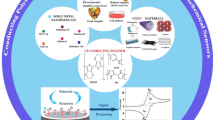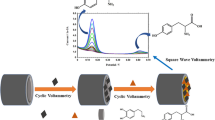Abstract
Composite electrodes made of graphite, paraffin and metal hexacyanoferrates exhibit a voltammetric response of the hexacyanoferrate ions, the potential of which depends linearly on the logarithm of concentration of alkali and alkaline-earth metal ions. This behaviour has been observed on account of the fact that the electrochemical reaction is accompanied by an exchange of these ions between the solution and the zeolitic lattice of the hexacyanoferrates for charge compensation. The voltammetric determination of the formal potential of these electrodes in a solution allows the quantitative analysis of the ions which are exchanged between the metal hexacyanoferrates and the aqueous solutions. Iron(III), copper(II), silver(I), nickel(II) and cadmium(II) hexacyanoferrates have been studied for the determination of H+, Li+, Na+, K+, Rb+, Cs+, NH4su{+}, Mg2+, Ca2+ and Ba2+. In some cases, the selectivity constants are as low as 3·10−4, or even so small that their exact value is inaccessible. Electrodes made of iron (III), copper (II), silver (I), nickel (II) and cadmium (II) hexacyanoferrates are most suitable for the determination of potassium ions. Electrodes with nickel (II) and cadmium (II) hexacyanoferrates are also suitable for the determination of caesium ions. The working range of the electrodes also depends on the conductivity of the solutions and can range from 10−5 to 1 moll−1. Typical standard deviations of the potential measurements are 3 mV.
Similar content being viewed by others
References
Yu TR, Ji GL (1993) Electrochemical methods in soil and water research. Pergamon Press, Oxford
Khavas E (Havas J) (1988) Iono-i molekuljarno-selektivnyje electrody v biologicheskikh sistemakh. Mir, Moskva
Baucke FGK (1994) Fresenius J Anal Chem 349: 582–596
Ludi A, Güdel HU (1973) Struct Bonding 14: 1–27
Seifer GB (1962) Zh neorgan khimii 7: 1208–1209
Sharpe AG (1976) The chemistry of cyano complexes of the transition metals. Academic Press, London
Buser HJ, Schwarzenbach D, Petter W. Ludi A (1977) Inorg Chem 16: 2704–2710
Herren F, Fischer P, Ludi A, Hälg W (1980) Inorg Chem 19: 956–959
Dostal A, Meyer B, Scholz F, Schröder U, Bond AM, Marken F, Shaw SJ (1995) J Phys Chem 99: 2096–2103
Prout WE, Russel ER, Groh HJ (1965) J Inorg Nucl Chem 27: 473–479
Ceranic T, Trifunovic D, Adamovic R (1978) Z Naturforsch 33b: 1099–1101
Amos LJ, Duggal A, Mirsky EJ, Ragonesi, Bocarsly AB, Fitzgerald-Bocarsly PA (1988) Anal Chem 60: 245–249
Sinha S, Humphrey BD, Bocarsly AB (1984) Inorg Chem 23: 203–212
Schneemeyer LF, Spengler SE, Murphy DW (1985) Inorg Chem 24: 344–346
Moon SB, Xidis A, Neff VD (1993) J Phys Chem 97: 1634–1638
Engel D (1988) PhD thesis, University of Frankfurt am Main, Germany
Engel D, Grabner EW (1988) Z Phys Chem 151–168
Engel D, Grabner EW (1985) Ber Bunsenges Phys Chem 89: 982–986
Cox JA, Jaworski RK, Kulesza PJ (1991) Electroanalysis 3: 869–877
Scholz F, Lange B (1992) Trends Anal Chem 11: 359–367
Scholz F, Meyer B (1994) Chem Soc Rev 23: 341–347
Dostal A, Schröder U, Scholz F (1995) Inorg Chem 34: 1711–1717
Scholz F, Düssel H, Meyer B (1993) Fresenius J Anal Chem 347: 458–459
Düssel H, Komorsky-Lovric Š, Scholz F (1995) Electroanalysis (in press)
(1932) Gmelins Handbuch der Anorganischen Chemie, 8th edn, vol 59 B [Fe]. Verlag Chemie, Berlin
Shriver YDF, Shriver SA, Anderson SE (1965) Inorg Chem 4: 725–730
Ludi A, Güdel HU, Dvorak V (1967) Helv Chim Acta 50: 2035–2039
Ammann D, Chao P, Simon W (1987) Neurosci Letters 74: 221–226
Author information
Authors and Affiliations
Additional information
Dedicated to the memory of PD Dr. habil. Rainer Garten who passed away so early and has yet contributed so much to contemporary analytical chemistry
Rights and permissions
About this article
Cite this article
Düssel, H., Dostal, A. & Scholz, F. Hexacyanoferrate-based composite ion-sensitive electrodes for voltammetry. Fresenius J Anal Chem 355, 21–28 (1996). https://doi.org/10.1007/s0021663550021
Received:
Revised:
Accepted:
Issue Date:
DOI: https://doi.org/10.1007/s0021663550021




